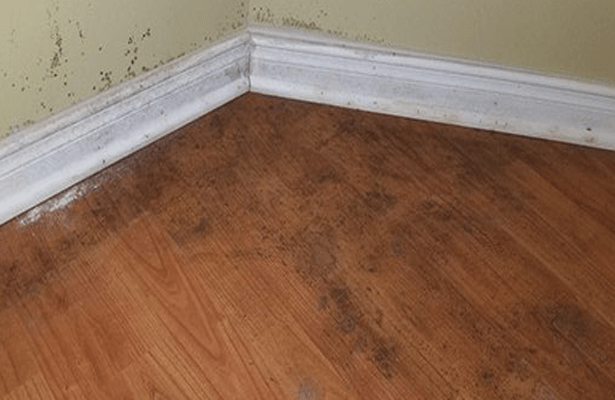Mold may do a great deal of a good job for nature by breaking down rotting matters. However, they are not friendly at all for your home, especially floors.
If you ever found a dark spot on the laminate flooring, RED FLAG! You have a mold colony underneath.
Numerous tips and advice on how to get rid of mold under laminate flooring will surely put you into a dilemma. So, we have rounded up the most proven ones and arranged them in the most effective order for your convenience.
Contents
7 Steps to Get Rid of Mold Under Laminate Flooring
Follow them to turn your floor FREE of any mold.
1. Keep the Floor Dry and Clean
Dirty and damp floors are the breeding grounds of molds. Even a handful of mold spores can turn into a colony in a damp environment. Thus, if you find dark spots on laminating a floor, ensure a dry and clean environment there.
Leaving shoes out of the room will ensure no additional spore or extra moisture is getting into the room. You can use a different shoe for the mold-contaminated room.
2. Remove the Uncontaminated Furnishings
Everything on the floor doesn’t need to be contaminated with mold. If the sporing is limited to a small space, consider yourself lucky. And remove all the uncontaminated furnishing like rugs or mats from the mold-free areas.
You need to dry them in sunlight and treat them afterward. This is a precautionary measure to eliminate any innocent mold spore that didn’t have the opportunity to flourish yet.
What about the furnishing from the molded part? Well, you have to say goodbye forever. No matter how perfectly you treat them, getting rid of mold 100% is not possible. Bag and seal them in a trash bag and throw it to the disposable.
3. Seal the Molded Room
The last thing you expect is to clean multiple rooms with molded floors. So to cut your time and cost down, immediately seal the molded room. It will prevent any spreading of the spores to other clean rooms.
Seal all the exit ways like windows and doors by hanging plastics. Then secure those with pins or duct tape. We would recommend keeping one window open for ventilation and light.
You can use a fan to blow the air out through the window. Wait, don’t point the fan towards the inside of the room or on the moldy patches. It will instead help the spores to flourish.
4. Remove the Laminate Flooring
Now comes the essential part of the task. Slowly remove the flooring of the molded area. If you are sure that the infestation is limited to space, just remove the flooring from there with a few extra.
Otherwise, you may have to go for the entire flooring. If you can spot multiple dark patches on the whole floor, it is better to go for the entire floor. Let’s not wait for any last-minute surprise.
How you will remove the flooring depends on the types. In the case of laminate flooring, start from a corner and remove section by section. If the dark patches are on the corners, you are good. But if they are in the middle of the room, you have to take almost the entire flooring.
5. Discard Contaminated Floorings
It is obvious that the laminate flooring and the sub-floor underneath the contaminated floor covering cannot be in the room anymore. Bag and seal the molded laminate flooring immediately if you found them being treated.
According to the professional mold treatment specialist, it is better to discard them. Scrap the contaminated sub-floor up to the depth you found the mold spores. And for a lasting effect, scrap a few extra.
6. Treat with Borax
What if the lamination is still usable? Well, you can treat them and use them again. Mix a cup of Borax with one gallon of water into a bucket. Put the mixer in a spray bottle and use it for treating the cleaned area and reusable laminations.
If the area is too big or too many planks to treat, empty the bucket on them. You can spread them evenly by using a brush or broom. Sub-floors will give a better outcome if you swab them with a borax solution. Then wait 10-15 minutes. It will saturate the molds and weight them down. Now the spores will not release again.
7. Vacuum the Floor
Lastly, you need to vacuum the treated area or the laminations. The vacuum will remove any inactive spore that is yet to bloom and contaminate the floor. We will recommend using a HEPA vacuum for the best outcome. This will trap all the dried spores and remove them for good.
The vacuum will also keep the treated area dry from the oversaturation of water. If you leave the treated area or laminations wet, it will only ignite the sporing. And if this happens, both the sub-floor and the overlying laminations will be beyond treatment.
You need to spray a fresh borax solution over the treated area at the end of this step. Wait for a few minutes and dry up the solution using heat. Lastly, run the dehumidifier to dry up the last drops of moisture. Now the remaining borax residue will prevent any growth of mold in the future.
What’s Next: Does Laminate Flooring Need to Acclimate
Conclusion
Mold under the laminate flooring is definitely frustrating. But they are not an impossible task to wrap up. Follow the order of the steps to remove mold under the lamination flooring successfully.
One thing we can ensure is that the mold will be on the bay for a long time. Unless the floor is flooded or you keep it wet for some reason.

